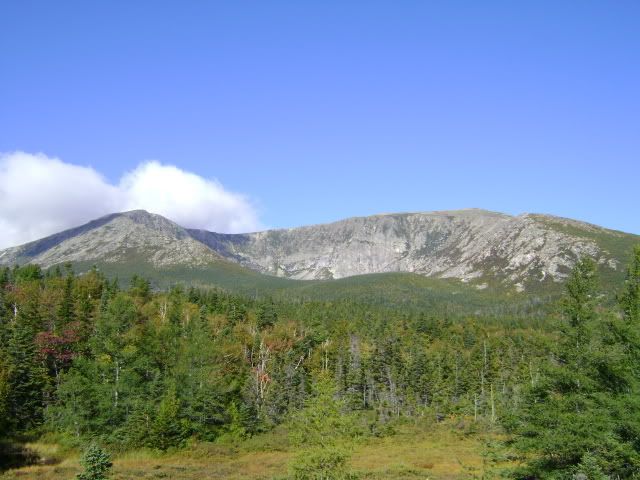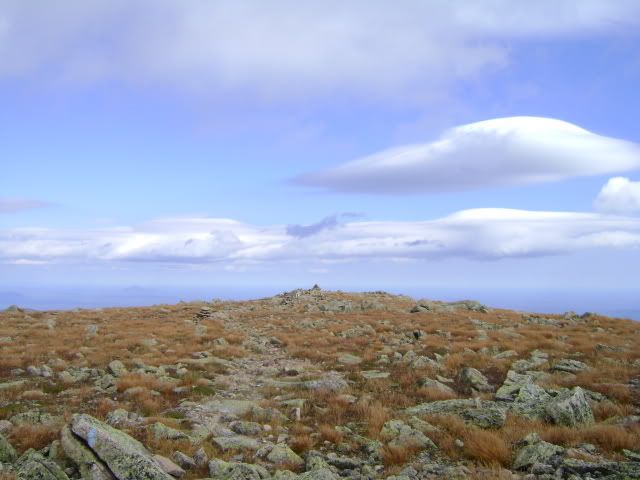Why I have the best major ever.

View looking east from the Hamlin Ridge on Maine's Mt. Katahdin.
So, on September the 16th, my "Field Natural History" class took a trip up to Baxter State Park in north-central Maine. Leaving Orono well before the crack of dawn, we arrived at the trailhead, near the Roaring Brook Campground, early in the morning, with the chill of the night still upon the land. We immediately began ascending the trail, up through forests of maple and birch.

A mass of yellow birches that were already beginning to change into fall colors.
The campground and parking lot are at about 450 m above sea level. Several hundred meters farther up into the atmosphere, and spruces and firs became increasingly common, as did mountain-ash. The mountain-ashes (Sorbus spp.) in particular were lovely. I am used to seeing them only as an ornamental, well-manicured and planted in the open. So, seeing so many of these sacred trees growing wild was quite an experience. Perhaps it was simply the novelty of the experience, but they seemed to exude a great degree of self-possession. They were surprisingly suave, cultivated, and cosmopolitan for trees living in so rugged an environment. It was like discovering an old 19th-century "mountain man" quoting verbatim from Catullus!

A canopy of ferny mountain-ash leaves shading the trail near the turn-off towards Hamlin Peak.

Dr. Glanz, lecturing, accidentally strikes a dramatic pose in the midst of a black spruce/balsam fir forest.
At around 710 m up, we stopped at a rocky moraine flanked by a small Sphagnum moss/tamarack bog. This area was particularly wind-swept, and so featured dwarf trees and shrubs usually found only at much higher elevations. Stunted black spruce emerged six or seven feet tall from the rocky substrate, with tiny labrador tea and sheep laurel growing to half a meter at their feet. It was windy, and clear-skied, and bright.

My classmates give perspective on the size of the stunted forest.

A cloud passes over the horseshoe-shaped main body of the mountain.
Further up, we passed once again through denser forest, with (relatively) tall black spruce trees rubbing shoulders with paper birch, mountain-ash, balsam firs, and the occasional struggling red maple. The rocks strewn across the ground were covered with copious lichens of many forms and colors. Blueberry bushes also became increasingly common, and we all supplemented our packed food with handfuls of these little fruits.

Wild blueberries and cranberries growing near a boulder above treeline.
Eventually, as the last caption indicates, we emerged from out the forests that gird the mountain, and came up into the open air. The path was increasingly steep and rocky, and we had to scramble our way up it, pulling ourselves up over and around large granite boulders. The only trees left were miniaturized and wind-beaten balsam firs, and tiny mountain-ashes hiding behind rocks to protect themselves from the wind. Cushion plants - Diapensia spp. - grew in strange puffs on the barren ground, as did tiny blueberry bushes. In fact, the ground cover was rather rich, with labrador tea, cranberries, sedges, sheep-laurel, and the occasional moss. We stopped for lunch, and a lecture.

A wind-blasted fir skeleton watches out over the landscape.

The view was spectacular.
At this point, we had hiked four miles, gaining about 2000 feet (600 m) of elevation in the process. Dr. Glanz, begging a bum knee, turned to head back down, and invited anyone who was getting exhausted to join him. About a third of the class went. The rest of us, under the leadership of our TA, continued up the mountain. The air was much thinner at this altitude than it had been way down in Orono seven hours before, and I, unadjusted, was finding it quite hard to breathe. Nevertheless, there was no way in hell I was going to refuse to try making the top.

The top
At around 2:00 PM, after an additional mile of hiking, with a ∆H of an additional 1000 feet (it was a steep climb), we reached Hamlin Peak, 4751 feet above sea level, roughly a kilometer higher than our starting point at Roaring Brook. Mt. Katahdin has several peaks, and Hamlin is not the highest of them; that honor belongs to Baxter peak, 5267 feet above sea level. That wasn't on our agenda this time, but, as the C.L.A.W. says, "Next time, Gadget!" Hamlin peak was really more of a nub atop a significant expanse of barren tableland. Only browning sedges, cushion plants, and the occasional tiny, inch-tall shrub grew there. We turned to the south, and hiked a little way along the tablelands, before heading down the Saddle Trail, through dense thickets of alder and over loose boulder fields, to the Chimney Pond campground, where we met up with the other third of the class.

The class makes a "mule train" along Hamlin Ridge, flanked by occasional dwarf forests of Krummholtz, or stunted, wind-tortured alpine trees. Ah, exploration! Adventure! To the left, you can see the terrifically steep saddle formation for which the saddle trail is named, and which we hiked down.
On the way down the mountain, we were all eager to return to civilization, and so we made a forced march at an incredible pace, pulling four miles in two hours on very sore ankles. We were able to make it back to campus before the cafeterias closed, and so could have nice, warm dinners. Alas, though, we never stopped for long enough for me to get out my camera and take pictures.
The End!
Amazed he's getting credit for this shit since 1986,
--mark